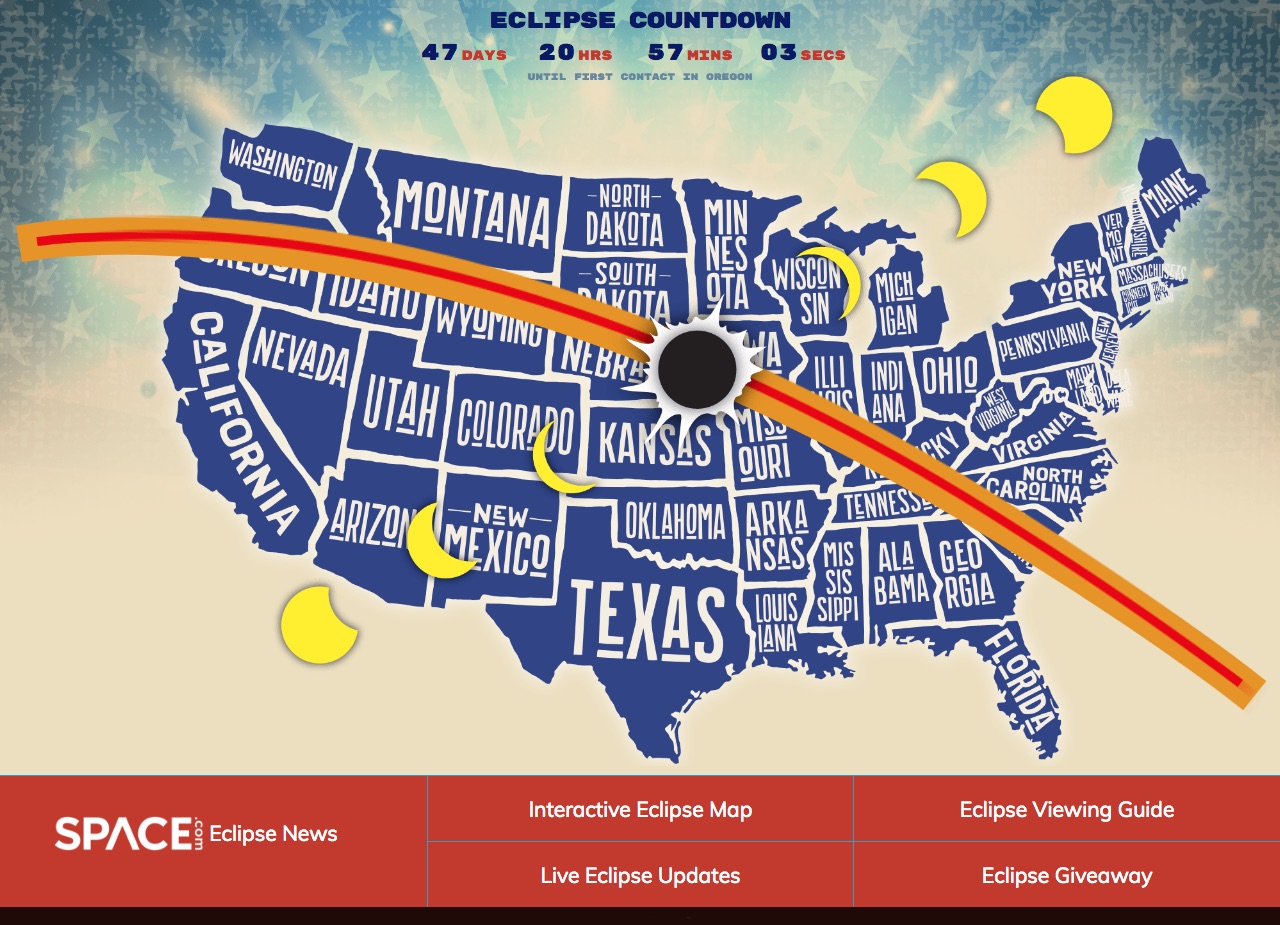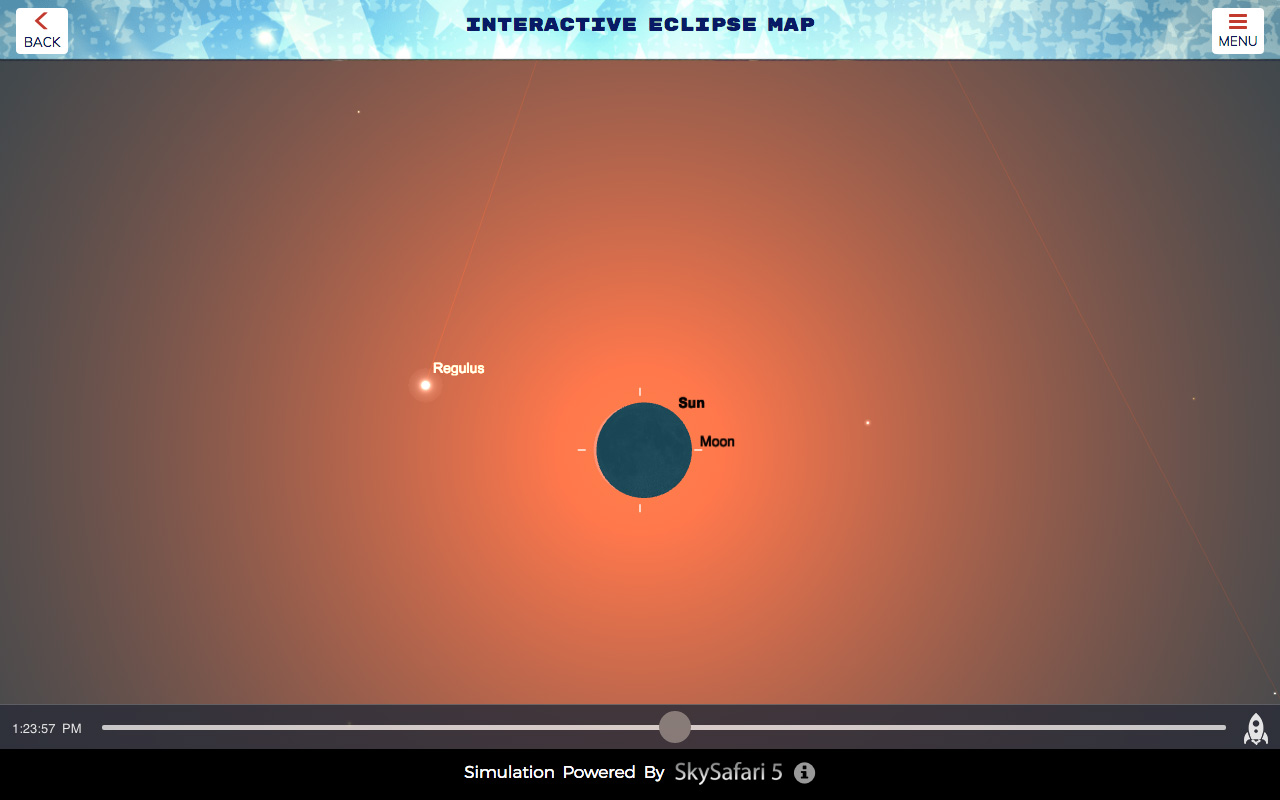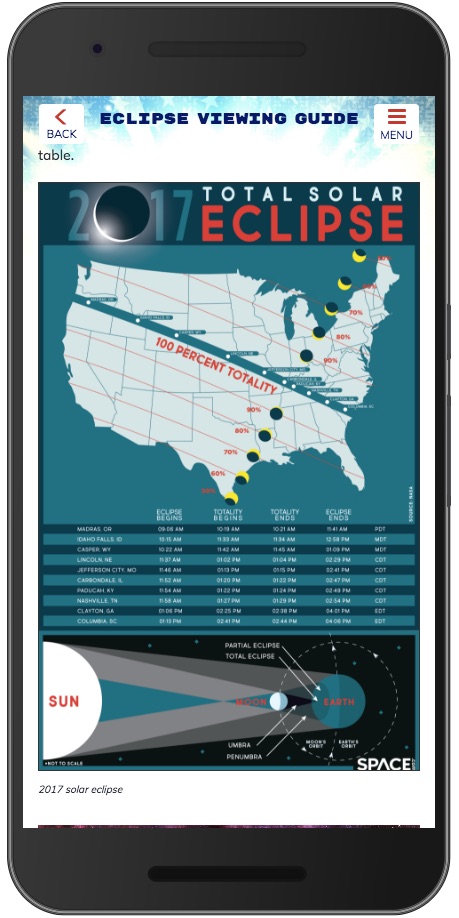Enjoy an Eclipse Safari! Total Solar Eclipse App Features Interactive Map and Space.com News

We here at Space.com are working hard to keep our readers informed about the Aug. 21, 2017 total solar eclipse. It's with that goal in mind that we decided to partner with Simulation Curriculum — the creators of the amazing astronomy and skywatching mobile app SkySafari — on their new total solar eclipse mobile app, Eclipse Safari.
The Aug. 21 total solar eclipse will cross the continental U.S. from Oregon to South Carolina; a partial eclipse will be visible from most of North America. Wherever you are, Eclipse Safari can help you make the most of this skywatching opportunity by letting you know exactly when the eclipse will start in your location, how long it will last and when it will end.
Eclipse Safari also provides users with general eclipse information and viewing-safety guidelines from Space.com. But what really sets the app apart is that it regularly updates with a list of eclipse articles from Space.com and from around the web. The free app is available for Apple and Android, and you can view it on the web. [The Best ISO-Certified Gear to See the 2017 Solar Eclipse]
"Eclipse Safari offers a really good combination of great content, timely news articles and an interactive map that allows you to find the best location near you to view the eclipse for the best experience," Pedro Braganca, director of education and content for Simulation Curriculum, told Space.com. "The primary focus of the app is to keep you up to date with all the latest eclipse news and events. So each time you login, there is always something new to learn about."

The app is composed of seven main features:
― The interactive eclipse map.
― An up-to-date list of eclipse-related articles from Space.com.
Get the Space.com Newsletter
Breaking space news, the latest updates on rocket launches, skywatching events and more!
― A countdown clock marking time until the start of the eclipse.
― An eclipse information guide and safe-viewing instructions.
― A simulated view of how the eclipse will look in the sky from any given location and a simulated view of how the eclipse will look from space.
― In-app updates from the Space.com twitter feed, featuring eclipse coverage from around the web, as well as a link allowing users to watch NASA's live eclipse webcast on the day of the eclipse.
― A section where users can enter to win eclipse prizes, including eclipse-viewing glasses, telescopes and binoculars.
Timing is everything
During a total solar eclipse, when the moon completely blocks the disk of the sun, viewers are plunged into darkness and are treated to an amazing sight as the turbulent layers of the sun's atmosphere become visible. The exact duration of this period of totality depends on where you are located, but it will last at most for about 2 minutes and 40 seconds. Because this event is so brief, skywatchers should make sure they know exactly when totality will begin and end in their location.

Eclipse Safari uses the incredibly accurate eclipse maps created by Xavier Jubier that use Google Maps to show exactly where the moon's shadow will fall and when. Jubier also helped build the interactive eclipse map used by NASA.
These maps are also useful to people outside the path of totality. Most of North America and Central America, as well as many people in South America, will be able to see a partial solar eclipse on Aug. 21, and the Eclipse Safari app will show users how much of the sun's disk will be covered by the moon from their location.
Simulation Curriculum is behind the SkySafari app, which makes it easy for people to find out what celestial objects will be visible from their location at any given time, or to identify night sky objects. It's also a massive celestial encyclopedia that can create a simulated map of the sky from any location on Earth, up to 10,000 years in the past or future. (The SkySafari software team also produce the Mobile Astronomy column for Space.com).
In 2015, the company released the Pluto Safari app around the arrival of NASA's New Horizon's probe at Pluto. The app showed users the location of New Horizons as it zoomed toward the outer solar system, provided basic information about the spacecraft and its payload, and delivered updates and pictures from the mission team.
"The Pluto Safari app was extremely successful. We had well over 100,000 downloads of that app, and our users really appreciated having a companion app to that historic event and mission," Braganca told Space.com. "So based on our experience with Pluto Safari, we came up with this idea of developing an app that is now called Eclipse Safari that allows users to get the most out of this unique viewing opportunity."
The software behind SkySafari 5, the most recent iteration of the app, is incorporated in the Eclipse Safari app and provides a simulation of how the eclipse will progress from a particular location. Users can scroll forward and backward in time, and watch the moon gradually cover the face of the sun, as those two bodies move together through the sky. Users can also see how the moon's shadow will look from space as it moves across the Earth.
We at Space.com are thrilled to partner with Simulation Curriculum on this project. We recommend the app even for skywatchers who don't plan on being inside the path of totality on eclipse day; they can still get up-to-date news and information about the eclipse, and play around with the interactive map and other features.
Editor's Note: This article was corrected to note that the total solar eclipse will last at most 2 minutes and 40 seconds, not 3.
Follow Calla Cofield @callacofield. Follow us @Spacedotcom, Facebook and Google+. Original article on Space.com.
Join our Space Forums to keep talking space on the latest missions, night sky and more! And if you have a news tip, correction or comment, let us know at: community@space.com.

Calla Cofield joined Space.com's crew in October 2014. She enjoys writing about black holes, exploding stars, ripples in space-time, science in comic books, and all the mysteries of the cosmos. Prior to joining Space.com Calla worked as a freelance writer, with her work appearing in APS News, Symmetry magazine, Scientific American, Nature News, Physics World, and others. From 2010 to 2014 she was a producer for The Physics Central Podcast. Previously, Calla worked at the American Museum of Natural History in New York City (hands down the best office building ever) and SLAC National Accelerator Laboratory in California. Calla studied physics at the University of Massachusetts, Amherst and is originally from Sandy, Utah. In 2018, Calla left Space.com to join NASA's Jet Propulsion Laboratory media team where she oversees astronomy, physics, exoplanets and the Cold Atom Lab mission. She has been underground at three of the largest particle accelerators in the world and would really like to know what the heck dark matter is. Contact Calla via: E-Mail – Twitter









